Ulnar Nerve Palsy or Entrapment:
Table of Contents
What is Ulnar nerve Palsy?
In the ulnar nerve palsy, the patient can not able to do fine movements and daily routine tasks, muscles become wasting, or atrophied.
The ulnar nerve is a major peripheral nerve of the upper limb. It supplies motor and sensory functions to the upper extremity. The ulnar nerve originates from the ventral rami of C8 and T1 nerve roots of the spinal cord. The nerve courses in the medial arm and forearm, and then it passes into the wrist, hand, and fingers. The ulnar nerve allows fine movements of fingers. It controls some of the muscles of the forearm that allow the gripping movement. The ulnar nerve creates the shock-like sensation when hitting the funny bone by any things in your elbow.
If the ulnar nerve is damaged, the muscular weakness and sensations are lost in the area where the ulnar nerve is supplied. It is known as ulnar nerve palsy or ulnar neuropathy. In the ulnar nerve palsy, the patient can not able to do fine movements and daily routine tasks. In severe cases, muscles become wasting, or atrophied, which makes the hand like a claw(claw hand). So surgery is sometimes necessary to correct it.
Anatomy of Ulnar Nerve:
The ulnar nerve starts from the brachial plexus within the axilla. It is a part of the medial cord and originates from spinal roots C8 and T1. The ulnar nerve runs downward and passes behind the medial epicondyle of the humerus at the elbow. The ulnar nerve doesn’t give branches in the upper arm. It gives muscular and cutaneous branches in the forearm and hand. The ulnar nerve enters the forearm between the two heads of the flexor carpi ulnaris muscle and travels deep muscle, along with the ulnar side.
Three main branches arise in the forearm:
- Muscular branch – supplies two muscles in the anterior compartment of the forearm.
- Palmar cutaneous branch – supplied to the medial half of the palm.
- Dorsal cutaneous branch – innervates the dorsal surface of the medial one and a half fingers, and the dorsum side of the hand. The
ulnar nerve becomes entrapped or irritated when it passes behind the medial epicondyle. The ulnar nerve passes through the cubital tunnel that runs under the medial epicondyle. The flexor carpi ulnaris and medial half of flexor digitorum profundus muscle these two branches supplied by the ulnar nerve.
At the midpoint of the arm, the ulnar nerve enters the posterior compartment and passes posterior to the elbow by the ulnar tunnel. it gives to arise articular branch which supplies the elbow joint.
At the wrist, the ulnar nerve travels superficially to the flexor retinaculum and medially to the ulnar artery. then it enters the hand by the ulnar canal (Guyon’s canal) and gives to the superficial and deep branches. The superficial branch of the ulnar nerve supplies and passes under the Palmaris brevis muscles and divides into palmar digital nerves.
The deep branch of the ulnar nerve supplies the three hypothenar muscles, the two medial lumbricals, the seven interossei, the adductor pollicis, and the deep head of the flexor pollicis brevis. It supplies all intrinsic hand muscles which lie medial to the flexor pollicis except the last lateral two lumbricals.
Branches of ulnar nerve:
- Muscular branch
- Palmar cutaneous branch
- Dorsal cutaneous branch
Muscles supplied by the ulnar nerve & Its function:-
Muscular branch and its function:
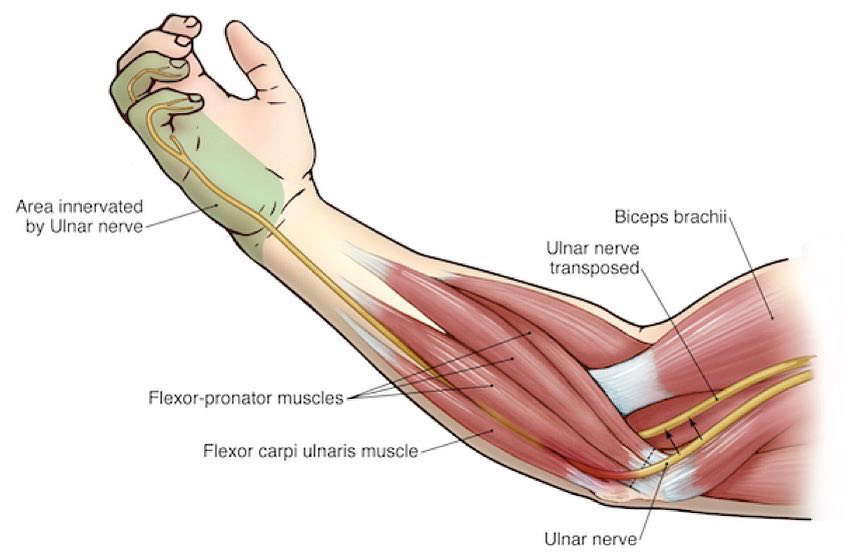
In the anterior forearm: Flexor carpi ulnaris -flexes and adducts the hand at the wrist.
The medial half of Flexor digitorium profundus -flexes the ring and little fingers at the distal interphalangeal joint.
In the hand:
- Hypothenar muscles (flexor digiti minimi brevis, abductor digiti minimi, opponens digiti minimi)
- Medial two lumbricals
- Adductor pollicis
- Interossei of the hand
- Palmaris brevis
- All these muscles also help to flex and adduct the ring finger and little finger.
Sensory branch and its function:
Palmar cutaneous branch– Supplied the medial half of the hand
Dorsal cutaneous branch– Supplied the medial one and a half fingers, and the related dorsal hand area.
Superficial branch– Supplied the palmar surface of the medial one and a half fingers.
The ulnar nerve gives sensations like pain, temperature, touch, etc to these muscles in the medial half of the palm and the last two fingers.
What is ulnar nerve palsy or entrapment?
Ulnar nerve entrapment is the most common condition of the ulnar nerve. Ulnar nerve entrapment presents when something puts pressure on the ulnar nerve on the elbow or at the wrist. Nerve entrapment is a type of nerve compression syndrome.
Nerve compression can lead to inflammation of the nerve or neuropathy (nerve damage). In that cases, it may affect the grip strength so the patient has difficulty grasping items.
Ulnar nerve entrapment is also known as:
- Bicycler’s neuropathy or handlebar palsy
- Guyon’s canal syndrome
- Tardy ulnar palsy
- Cubital tunnel syndrome
Causes of ulnar nerve entrapment :
Ulnar nerve entrapment at the elbow (Cubital tunnel syndrome)can occur when there is prolonged stretching of the nerve by an elbow in a fully flexed position for a prolonged time or when direct pressure on the nerve by any things or any prolonged position of the hand.
In other, ulnar nerve entrapment at the wrist(Guyon’s canal syndrome) can occur when direct pressure on the nerve by the use of handlebars during long bike rides(Handlebar’s palsy) or long time use of hand tools. Similar to the person’s arm “going to sleep,” or “hitting the funny bone,” an entrapped ulnar nerve can resulting tingling, pain, and numbness in certain areas.
It can also occur in any type of traumatic condition, swelling, fractures, vascular and bony pathologies/abnormalities, and repetitive stress on the nerve. Guyon’s canal can also result from excessive gripping, twisting, or repeated wrist and hand movements.
Entrapment may also develop if the hand is in a flexed position and the ulnar deviated for prolonged periods of time.
Other causes of ulnar nerve palsy are the following:
- Any illness that damages your nerve
- Any type of the ulnar nerve injury
- Excessive pressure on the nerve
- Due to swelling
- Any type of elbow fracture or dislocation.
- Arthritis.
- Diabetes.
- Pressure due to plaster casts or splints or using elbow crutches.
- Tumors or cysts.
- The ulnar nerve damage is similar to cutting a telephone cord. so that the message cant reach the supplied area.
Symptoms of ulnar nerve palsy:-
Ulnar nerve palsy is a progressive condition, and it may get worse over a period of time.
The symptoms of ulnar nerve palsy include:
- A decrease in the sensation in your hand, mostly in your ring and little fingers.
- A loss of coordination in your fingers.
- A tingling, numbness, or burning sensation in your hand.
- Pain in the elbow.
- Hand weakness is present and it may get worse with physical activity.
- Loss of grip strength.
- Decrease strength in your hand can affect your daily routine activities, like gripping the glass and holding a pencil, etc.
- The lack of control and sensation can cause the muscles to tighten in a hand, leading to a claw-hand-like deformity.
- Muscle wasting.
- The feeling of “falling asleep” in the ring finger and little finger, especially when your elbow is in a flex position. In that cases, it may be harder to finger movement and hold the object.
- if it is not treated early so that it presents for more than 6 weeks.
What are the risk factors for the ulnar nerve entrapment?
- Ulnar nerve entrapment affects men compared to women. People who do jobs or activities to continue for a prolonged period of time, they have a lot of elbow or wrist pressure or stretching are most at risk, such as the following:
- Baseball players, golfers players, and table tennis players.
- Bicyclists.
- Construction workers.
- People who smoke.
- Office workers like Typists, writers, and others who used a keyboard frequently.
- Weightlifters.
Clinical relevance of ulnar nerve injury:
Symptoms of ulnar nerve entrapment include tingling in the fingers entrapment path, decrease grip strength, pain and loss of sensitivity on the ulnar side of the forearm, wrist, and hand, muscle atrophy, and clawing of 4 and 5th digits of a finger in hand (a sign of benediction).
according to the area in which ulnar nerve entrapment is given symptoms or conditions are the following:
1)Cubital tunnel syndrome
2)Guyon’s canal syndrome
Cubital Tunnel Syndrome:
If the ulnar nerve entrapment in the cubital tunnel at the wrist due to the narrowing of the canal so that the symptoms can arise its called a cubital tunnel syndrome.
Symptoms: pain, weakness, tingling present in forearm muscles supplied by the ulnar nerve, sensation may be lost.
cubital tunnel syndrome is present in different grades of severity.
Grade I: Mild symptoms:
Intermittent paresthesia.
Less hypoesthesia of the dorsal (back side)and palmar(front side) surfaces of the 5th and medial half of the 4th digits.
Movements are not affected.
Grade II: Moderate symptoms:
Paresthesia.
Numbness in the dorsal and palmar surfaces of the 5th and medial side of the 4th digits.
Mild weakness muscles are supplied by the ulnar nerve.
Muscular atrophy.
Grade III: Severe symptoms:
Paresthesia
Loss of sensation of the dorsal and palmar surfaces of the fifth and medial sides of the fourth digits.
Functional and motor impairment.
Muscle atrophy of the hand intrinsic muscles.
Clawing of fourth and fifth digits of fingers in hand(Sign of Benediction).
Guyon’s Canal Syndrome symptoms include:
- In this condition, the ulnar nerve impinges at the wrist, and symptoms arise.
- Muscular atrophy – The hypothenar muscles and interossei muscle-sparing of the thenar group:
- Weakness in finger abduction and adduction movement (interossei muscle)
- Weakness in thumb adductor muscle (adductor pollicis)
- Sensation loss and pain in the palmar surface of the 5th digit and medial aspect of the 4th digit and the dorsum of the medial aspect of the fourth finger and the dorsum of the fifth finger don’t have sensory loss.
- Ulnar Claw hand may present (a sign of Benediction)
When should I go to the doctor?
You should go to your doctor if you experience the following symptoms or disturbing in your daily activity.
- Difficulty to pick up or holding items to hand.
- Elbow or wrist pain.
- Numbness or tingling in the fingers or whole hand.
- Difficulty in daily tasks like buttoning a shirt or holding a pen.
Diagnosis of ulnar nerve palsy and entrapment:
If a person has any of the symptoms of ulnar nerve entrapment for more than a few weeks, they should contact a doctor on an early basis. The doctor will discuss the patient about medical history and general health. They may also ask about patients’ work, their activities, and what medications they are taking. After discussing the patient’s symptoms and medical history, A doctor will examine the patient’s arm and hand to diagnose which nerve is compressed and in which area the nerve compression is present.
After that, the doctors check the symptoms by some physical examination tests, and the diagnosis is confirmed. Some special tests are following:
Froment’s test: In this test, a doctor gives a piece of paper to the patient and asks him to hold it in between the thumb and index finger. If the patient cant hold it and the interphalangeal joint at the tip of the thumb is given the flexing movement ad leave a paper so that sign indicates the nerve problem.
Tinel’s test: A doctor gently taps on the patient’s elbow’s funny bone (ulnar nerve) with any type of thing or hammer. And patient feels an extreme shock-like sensation in the ring finger so that sign suggests an ulnar nerve problem.
Wartenberg’s sign: In this test, the doctor asked the patient to spread his whole fingers apart and then back fingers together, doctor observe this movement, and if the patient can’t do the last two fingers apart and back together so the patient had the ulnar nerve problem.
ULTT3 performs according to the patient’s symptoms.
Check the ROM(Range of motion) of that affected part.
Sensory examination: check the sensation of the whole part supplied by the ulnar nerve.
Radiological investigation:
The radiological investigations are given the proper nerve pathway and nerve’s electrical activity in the whole supplied area. so that if any path ulnar nerve is pinched, it is detected and the doctor takes a confirmed diagnosis.
Electromyography (EMG) Test: This test includes nerve conduction studies and measures how signals travel through nerves and to stimulate muscles.
Xray: The X-rays give detailed pictures of bone structures. The compression of the ulnar nerve cannot be seen in the X-ray.
However, the doctor may take X-rays to evaluate any type of wrist and elbow fracture or any arthritis condition involving the nerve entrapment.
MRI Test:- In MRI uses specific sequences that produce enhanced images of particular nerves. In that check, whether the spinal roots are involved or not.
NCV(Nerve conduction studies) Test: This test is given the electrical function of the nerve. so that this test can help to diagnose nerve is working properly or not and help to identify where it is being compressed.
Nerves are like electrical cables group and it that travel through the body and carry messages from the brain to muscles. When a nerve is not working well or electrical impulses can reach the muscle, it takes a longer period of time to conduct the muscle.
In the nerve conduction test, the nerve is stimulated in one place and noted the time to response of the stimulated muscle is. If the compression and any other problem in between nerve paths so the response of muscle takes a longer time.
Nerve conduction studies can also evaluate whether the compression is also caused by muscle damage. During the test, small needles are put into some of the muscles that control by the ulnar nerve. Muscle damage is a response to more severe nerve compression.
Proper diagnosis of ulnar nerve entrapment is key to avoiding long-term symptoms of loss of function and sensation in the affected hand and fingers. and break the condition become more severe.
What is the treatment of ulnar nerve entrapment?
Non-Surgical Treatment:
ulnar nerve entrapment treatment is depending on the severity of the symptoms of entrapment.
in an early stage of the condition, a doctor will recommend first nonsurgical or medical treatment, treatments are the following:
- Use anti-inflammatory drugs to reduce swelling and pain.
- Wear elbow or wrist splints or braces to keep the elbow joint straight at the night.
- Exercises and physical therapy to help them improve the movement of the affected part.
- Occupational therapy help to learn things or perform a task in a new way so that less irritation of the ulnar nerve.
If the condition becomes more severe and nonsurgical treatment is don’t help to relieve the symptoms a doctor recommends surgery, depending on the causes of nerve entrapment to relieve the symptoms :
Surgical treatment :
The goal of surgery:
- Release the ulnar nerve at which that entrapment.
- Remove any type of tumors or cysts.
- Decrease the symptoms of nerve entrapment.
Different patterns of surgeries are following:
Cubital tunnel release: In this procedure increase the size of the cubital tunnel and give more space to the nerve.
Ulnar nerve anterior transposition: In this procedure move the nerve from behind the muscle to in front of the muscle, so there is a decrease in the tension on the nerve when the elbow is in flex position or movement.
Medial epicondylectomy: In this procedure removes the part of the protruding medial bone to prevent the nerve from rubbing on the surface of that area.
At the Wrist: If the compression at the wrist, the surgeon makes the incision and accesses the ulnar nerve, and performs decompression of the ulnar nerve at the wrist.
Doctors will use these different types depending on the compression area as the first line of treatment.
Physiotherapy Treatment of ulnar nerve entrapment:
The Impairment-based approach can be used to increase strength, ROM, and the attainment of functional goals of hand. treatment is based on the patient’s difficult activity or functional task so that pain is reduced and improve the functional movement.
Wearing a splint – An elbow brace worn at night for three months so that it prevents elbow flexion beyond 45 degrees.
Nerve gliding exercise – Patients were instructed to complete nerve gliding exercises two times per day in six different positions and hold them for 30 seconds for three repetitions with a 1-minute break in between each repetition. Patients were instructed to complete these exercises until the next visit, which occurred 1-2 weeks later. The frequency of the exercises was increased to three times per day, holding the exercise for one minute each day for a period of three months if there were no symptoms at the next visit.
ICE massage: doctor advised the to patient apply the ice massage to the pain area to decrease the pain and spasm.
Neural mobilization.
Joint mobilization: The therapist gives the mobilization of the elbow or wrist which are affected to improve that movement.
Education: The therapist educates the patient about the condition and their symptoms and teaches how to relieve that, improve activity without pain, and modify some working patterns.
Electrical modality: ES (Electrical stimulation) is important in nerve injury, When a Patient comes with Nerve Injury first Requires SD CURVE of the injured nerve by giving to the IG Current. if the nerve is in the innervated condition in the SD curve first we give the Ig (Galvanic current), and if the injured nerve shows the denervated condition in the SD curve, we give the SF currently. and in the recovery period, Faradic current is more useful for strengthening muscles from Grade 1 to 3 after that exercise regularly.
Exercises for ulnar nerve entrapment at the elbow:
Exercise 1: Elbow movement;
The first arm is extended and straight and your palm up.
Flex the fingers inward.
Flex the elbow, bringing the fist up toward the shoulder.
Return to your starting position. (extended position)
Repeat these exercises 3 to 5 times a day.
Exercise 2:
Extend the arm out to the side at shoulder level, and palm facing the floor.
Flex the hand upward, facing fingers toward the ceiling
Flex your elbow, bringing the hand toward the shoulder.
Repeat the exercise slowly and 3 times a day.

Exercises for ulnar nerve entrapment at the wrist:
Exercise 1:
Straight the arms.
Raise the affected arm and put the palm on the forehead.
Hold your hand there for a few seconds and then bring your hand down slowly.
Repeat the exercise a few times a day and increase the number of repetitions gradually.
Exercise 2: Stretching exercise;
Stand or sit tall with your arm held straight out to the front of you and your palm facing up.
Flex your wrist and fingers toward your body.
Do the hand away from the body and give a gentle stretch to the wrist.
Bend your elbow and bring your hand upward.
Repeat these exercises 2 times a day, gradually increasing the number of repetitions.
Home remedies treatment and prevention of ulnar nerve palsy:
Many different techniques are available that patients can do at home to relieve the symptoms. If your daily activity is disturbed in a few days or weeks don’t let it go in easy first u can go to your doctor for an early period of time.
- Avoid activities that cause you to keep your arms flexed for long periods of time. and straighten repeatedly.
- Make sure your sitting position is proper when u using a computer and any other work, your sitting posture is not too low compared to your desk level.
- Avoid pressure on your elbow or putting pressure on the inside of your arm. such example, don’t drive with your arm resting on the open window.
- Keep your elbow straight at night in sleeping mode. It can be done by wrapping a towel around your straight elbow or wearing an elbow pad backward.

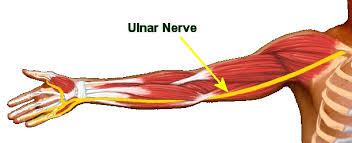
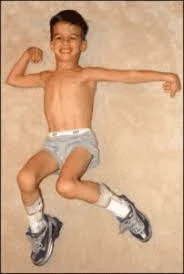

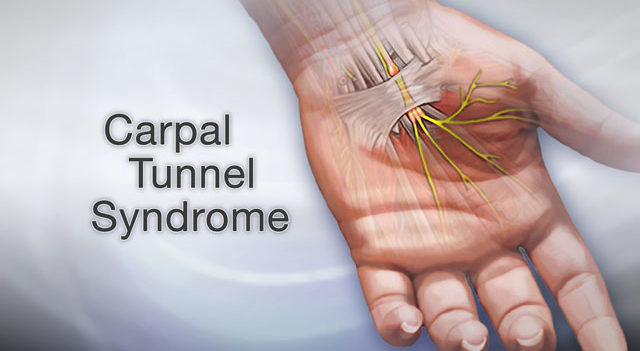
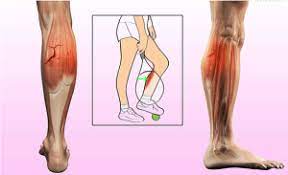


4 Comments